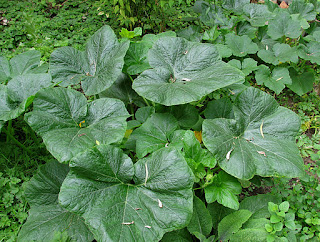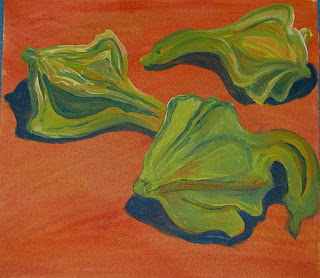 "Mysteriosa reptans" is the (pseudo) botanical name I gave to the mysterious vining plants that emerged spontaneously in our garden in July, no doubt volunteered from our home-brewed compost. By September, the four plants had produced two small pumpkins, two small acorn squashes, and three striped squashes of the "Heart of Gold" variety.
"Mysteriosa reptans" is the (pseudo) botanical name I gave to the mysterious vining plants that emerged spontaneously in our garden in July, no doubt volunteered from our home-brewed compost. By September, the four plants had produced two small pumpkins, two small acorn squashes, and three striped squashes of the "Heart of Gold" variety. If you read my previous post, you'll know about my seasonal fascination with the Cucurbit family (squash, pumpkin, melon) as the basis for a painting. This year, there was a remarkable convergence on this theme. As I set myself the challenge of painting our garden cucurbits, another garden was spontaneously generating in Manhattan.
If you read my previous post, you'll know about my seasonal fascination with the Cucurbit family (squash, pumpkin, melon) as the basis for a painting. This year, there was a remarkable convergence on this theme. As I set myself the challenge of painting our garden cucurbits, another garden was spontaneously generating in Manhattan.First, my painting:-- I set myself the challenge to create an interesting composition with seven objects very similar in shape and size (one usually chooses more variation). The outcome is "September Stripes," copyright 2011. (You can watch those stripes develop here.

Meanwhile, on the East Coast, my lifelong friend A was manipulating her long vines of knitting yarn to create some witty cucurbits and Indian corn (I must try that next year!) for No.1 Grandson's Halloween and for her own Thanksgiving table.

On close inspection, these are no ordinary veggies -- they're clearly heritage varieties!
 There are many smiles for me in this convergence -- a smile as I brought my painting together, smiles when I received A's stories and photos, and then...as the season progressed, a big smile as I put our garden squashes to their final use (saving their seeds for next year). As I pulled the first batch out of the oven, a line came back to me from Dylan Thomas' A Child's Christmas in Wales (relating to little boys pretending to smoke and then polishing off their candy cigarettes): "Then, with a smirk, we et them."
There are many smiles for me in this convergence -- a smile as I brought my painting together, smiles when I received A's stories and photos, and then...as the season progressed, a big smile as I put our garden squashes to their final use (saving their seeds for next year). As I pulled the first batch out of the oven, a line came back to me from Dylan Thomas' A Child's Christmas in Wales (relating to little boys pretending to smoke and then polishing off their candy cigarettes): "Then, with a smirk, we et them."















































